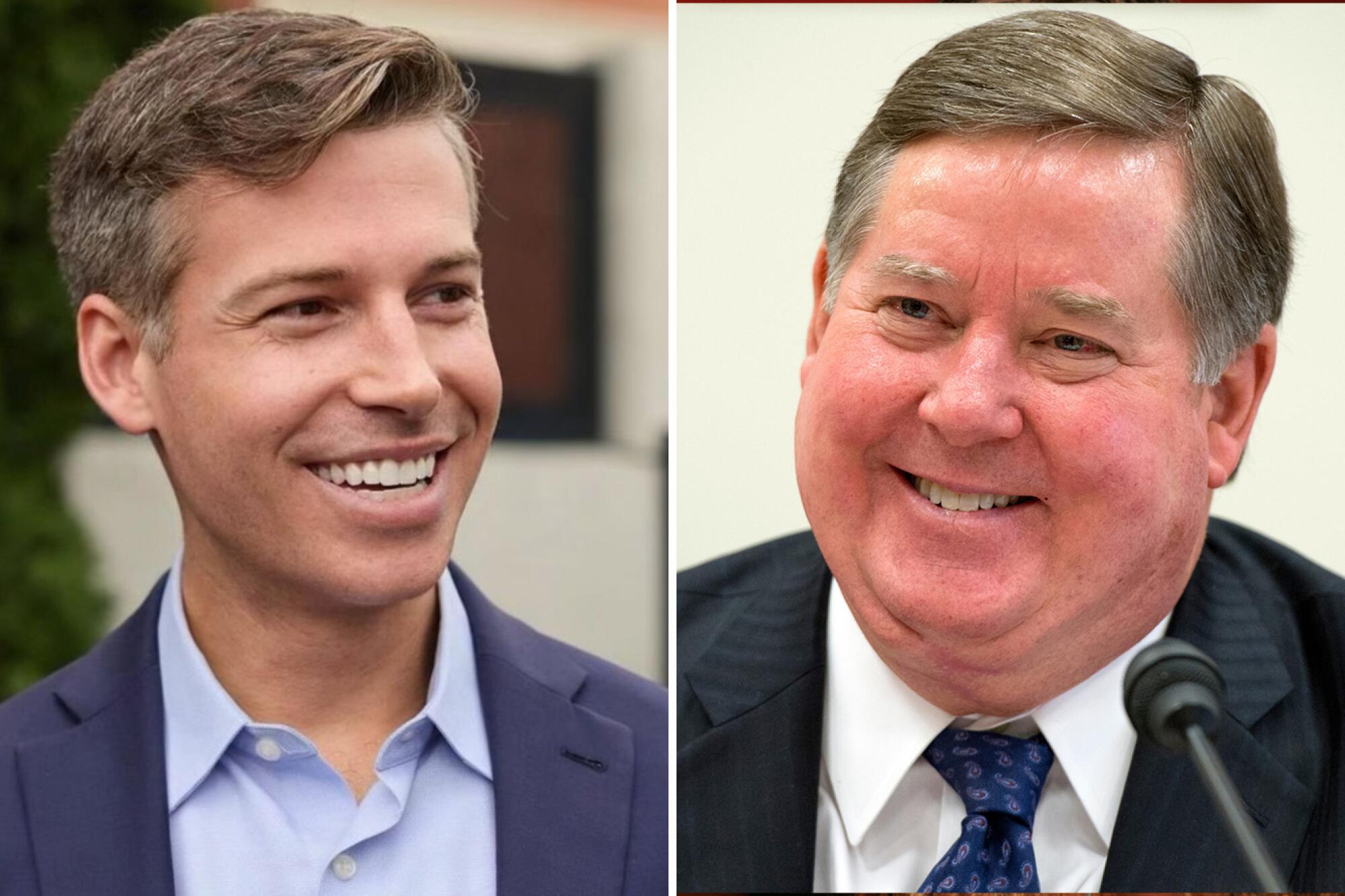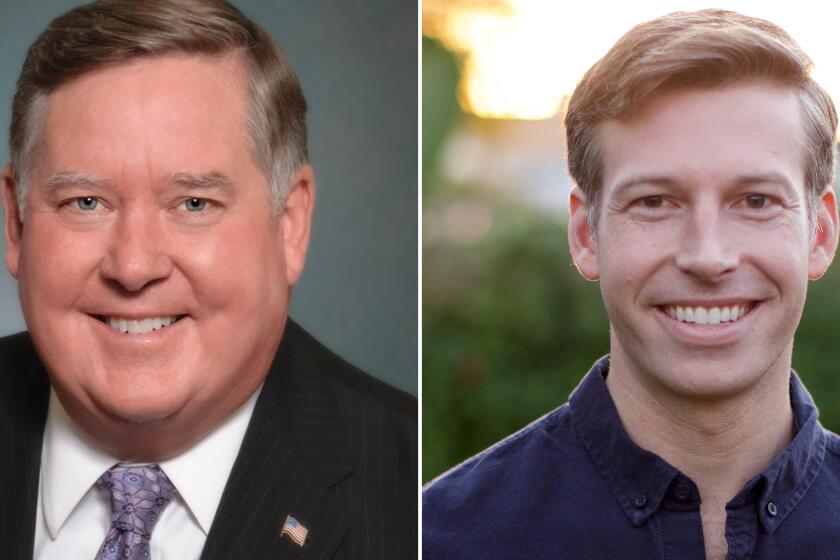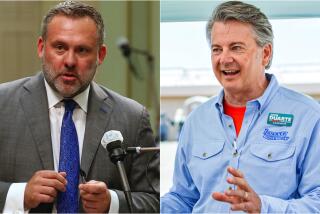
- Share via
CORONA — For decades, Rep. Ken Calvert, 71, presided comfortably over this corner of the Inland Empire. The lifelong Riverside County Republican largely coasted to reelection in a safely conservative district, eventually becoming one of the most senior members of the California House delegation.
But that evaporated in 2022, when Calvert was nearly toppled by a fresh-faced Democratic insurgent.
Will Rollins’ candidacy in California’s 41st District was made viable by redistricting changes the year prior that swapped Republican havens like Temecula and Murrieta for a swath of the Coachella Valley that included overwhelmingly liberal Palm Springs, home to one of the largest concentrations of LGBTQ+ voters in the country.
The 2022 race didn’t draw much attention at first. That quickly changed in the months prior to the election when the former federal prosecutor, now 39, showed he might have an actual shot at unseating the entrenched Republican stalwart. Rollins was briefly ahead on election night, though Calvert ultimately bested him by more than 11,000 votes.
Two years later, Rollins and Calvert are set for a 2024 rematch in what is now one of the most closely-watched races in the country.
The seat will likely play a crucial role in deciding which party dominates the U.S. House of Representatives next year, with partisan control of the House set to be determined by a handful of competitive seats in New York and California.
One story line drew particular attention during the last election, particularly in national media.
In a twist that one advocate described as “poetic justice,” Rollins was a young gay candidate battling an older Republican who had voted against LGBTQ rights in the past in a district that now included Palm Springs, the first city in the nation to elect an all-LGBTQ city council. (Calvert has said his views have since evolved, and the congressman voted in favor of a 2022 bill that affirmed same-sex marriage.)
Rep. Ken Calvert, who has opposed gay rights and once attacked an opponent for being gay, is facing a challenge from a gay Democrat in a newly competitive district.
All of those dynamics remain at play, and the addition of the Coachella Valley is precisely what made the district competitive.
But the Inland Empire suburbs still account for the vast majority of its voters, and it’s there, in the bedroom communities and increasingly diverse cul-de-sacs, that the battle for Calvert’s seat is really being fought.
Both sides say this year’s race will likely be dominated by kitchen-table issues including the daily cost of living, crime and housing, rather than the divisive culture wars that permeate the national political narrative, and that results will come down to what happens in the western Riverside suburbs.
“Corona, Lake Elsinore, Menifee, Eastvale, Canyon Lake, Norco — those are the cities that are going to decide the outcome of this election,” Rollins said, sitting at an oversize table in a Corona fire station. The local firefighters he’d been meeting with had just rushed out on an emergency call and the smell of their chorizo and eggs lingered, along with several hastily abandoned breakfast plates.
Those western Riverside enclaves are also the cities where Rollins is least well-known and Calvert — the son of a former Corona mayor — has long been a fixture.
“That’s why I’m here today in Corona,” Rollins said, noting that he’d been at the Corona Chamber of Commerce earlier that morning and tries to be in his Corona field office five days a week, about an hour-and-a-half commute from his Palm Springs home.
Though he is slightly graying at the temples, the 39-year-old candidate looks disarmingly boyish and could pass at first glance for an eager college student volunteer. Like Calvert, Rollins and his campaign team underscore the importance of turnout in the western part of the district, which has historically been far lower than in the Palm Springs area.
Those familiar with it describe the district as having two distinct hubs: a corner of the Inland Empire, which includes suburbs like Corona and Menifee and accounts for nearly 80% of voters, and a portion of the Coachella Valley, which includes communities like Rancho Mirage and Palm Desert, along with Palm Springs.
“I know this district inside and out, I was born here. I went to school here. I did business here, and have been representing this district,” Calvert said by phone on a recent Friday from his Corona real estate office in a Spanish-style building a stone’s throw from the 91 Freeway.
About 50 miles southeast of downtown Los Angeles at the western edge of the Inland Empire, Corona is the biggest city in the district and Calvert’s hometown.
Once dubbed “the lemon capital of the world,” it was a town dominated — and perfumed by — citrus for the better part of a century.
But orchards eventually gave way to new homes, neighborhoods and industry, and the Sunkist plant shut down in the early 1980s — the same decade the Riverside County city’s population began to explode, with aspiring suburbanites from Los Angeles and Orange counties driven inland for their slice of the American dream.
Amid a seemingly intractable state housing crisis, Corona and other inland cities in the district, such as Menifee and Lake Elsinore, have continued to boom. Spacious single-family homes can still be had for a fraction of what they would cost in coastal cities, though emigres to the Inland Empire often face lengthy commutes.
The families who arrived during the first waves of Corona’s population boom leaned more conservative, said Wes Speake, a Corona City Council member and president of the Corona Historic Preservation Society. Registered Democrats now slightly outnumber Republicans in the city, though folks still tend to be more fiscally conservative regardless of party affiliation, Speake said.
Speake — a Republican who has endorsed Calvert — attributes Corona’s shift to the center-left to a number of factors, including an “exponential” increase in diversity over the last two decades, younger and more liberal arrivals from Los Angeles and Orange counties, and Republicans changing their registration to no party preference.
More broadly speaking, the 41st District stands out as a rare piece of truly purple topography in a national landscape dominated by red and blue congressional districts.
Former President Trump won the district by just 1% in 2020, down five points from 2016, according to data from California Target Book. As of late May, Republicans held a razor-thin registration advantage, overtaking registered Democrats by a few thousand voters. But that advantage has see-sawed in the past, with Democrats holding an equally narrow upper hand during the 2022 election. Independents account for roughly 1 in 5 voters.
Trump endorsed Calvert in 2022, and the congressman has endorsed Trump’s 2024 presidential campaign. Rollins, a former assistant U.S. attorney in the National Security Division at the Department of Justice, has blasted Calvert for his continued support of Trump, even after Trump became the first former president to be convicted of felony crimes last month, with Rollins saying on the social media site X that the district deserves “a representative who cares more about the 750,000 of us in Riverside County than one convicted felon in New York.”
It remains unclear how Trump’s guilty verdict might affect Republicans congressional candidates in competitive districts like Calvert’s, or whether the conviction could nudge swing voters away from supporters of the former president.
“Riverside of 2024 is not Riverside of 1994,” said Sky Allen, executive director of Inland Empire United, a progressive political group that has endorsed Rollins. “The community looks different, our needs are different. And also, there’s a lot of people in our community that were never really represented by someone that holds conservative values.“
Allen cited the increased racial and ethnic diversity, more LGBTQ+ and immigrant families and more organizing from nonprofits like hers as factors shaping the district. In coordination with the super PAC Battleground California, Allen’s organization will be administering an independent expenditure in support of Rollins, with the bulk of its efforts concentrated on canvassing in the district.
Calvert and Rollins diverge on a number of pivotal issues. Calvert has said decisions on abortion should be left to the states and has an A+ rating on SBA Pro-Life America’s “National Pro-Life Scorecard,” whereas Rollins has been outspoken on protecting abortion rights and is backed by Planned Parenthood California’s political action committee. Rollins has advocated more gun-safety restrictions, whereas Calvert has voted against more stringent restrictions and received high marks from the National Rifle Assn.
Both candidates have criticized the country’s broken immigration system and advocated securing the country’s borders, but Rollins’ positioning also focuses on creating a path to citizenship for recipients of the Deferred Action for Childhood Arrivals program and other “qualified immigrants.”
Rollins’ unexpectedly narrow loss in 2022 left some prognosticators wondering whether more Democratic Party involvement in 2022 could have flipped the seat blue. Those what-ifs won’t be a question in 2024, regardless of what happens in November.
The Democratic establishment is putting its full backing behind Rollins. He’s one of the top candidates on the Democratic Congressional Campaign Committee’s “red to blue” list, a program that provides organizational and fundraising support, and he has also been the beneficiary of high-profile fundraising efforts, with Orange County Rep. Katie Porter blasting emails to her supporters on his behalf and House Democratic leader Hakeem Jeffries swinging through Southern California to headline a fundraiser.
The Republican party is putting similar institutional might behind Calvert, with significant investments in the district ranging from field support to TV.
Calvert retains the advantages of incumbency and ample name recognition, but Rollins has been a particularly prolific fundraiser. The Democratic challenger had roughly $500,000 more in his war chest than Calvert as of the end of March, according to federal filings. Money will be critical to either candidate getting their message out, especially with the western portion of the district overlapping with the extremely expensive Los Angeles media market.
“If you’re looking at the trend line, this new district is definitely moving toward Democrats after redistricting,” said Erin Covey, a House analyst at the nonpartisan Cook Political Report, citing the addition of Palm Springs and the fact that parts of the historically conservative Inland Empire have also shifted slightly to the left.
Calvert benefited from a newly-drawn Inland Empire district in 1992 when he was first elected to Congress, squeaking by just a few hundred votes. His fate now likely hinges on a narrow margin once again.
More to Read
Sign up for Essential California
The most important California stories and recommendations in your inbox every morning.
You may occasionally receive promotional content from the Los Angeles Times.











